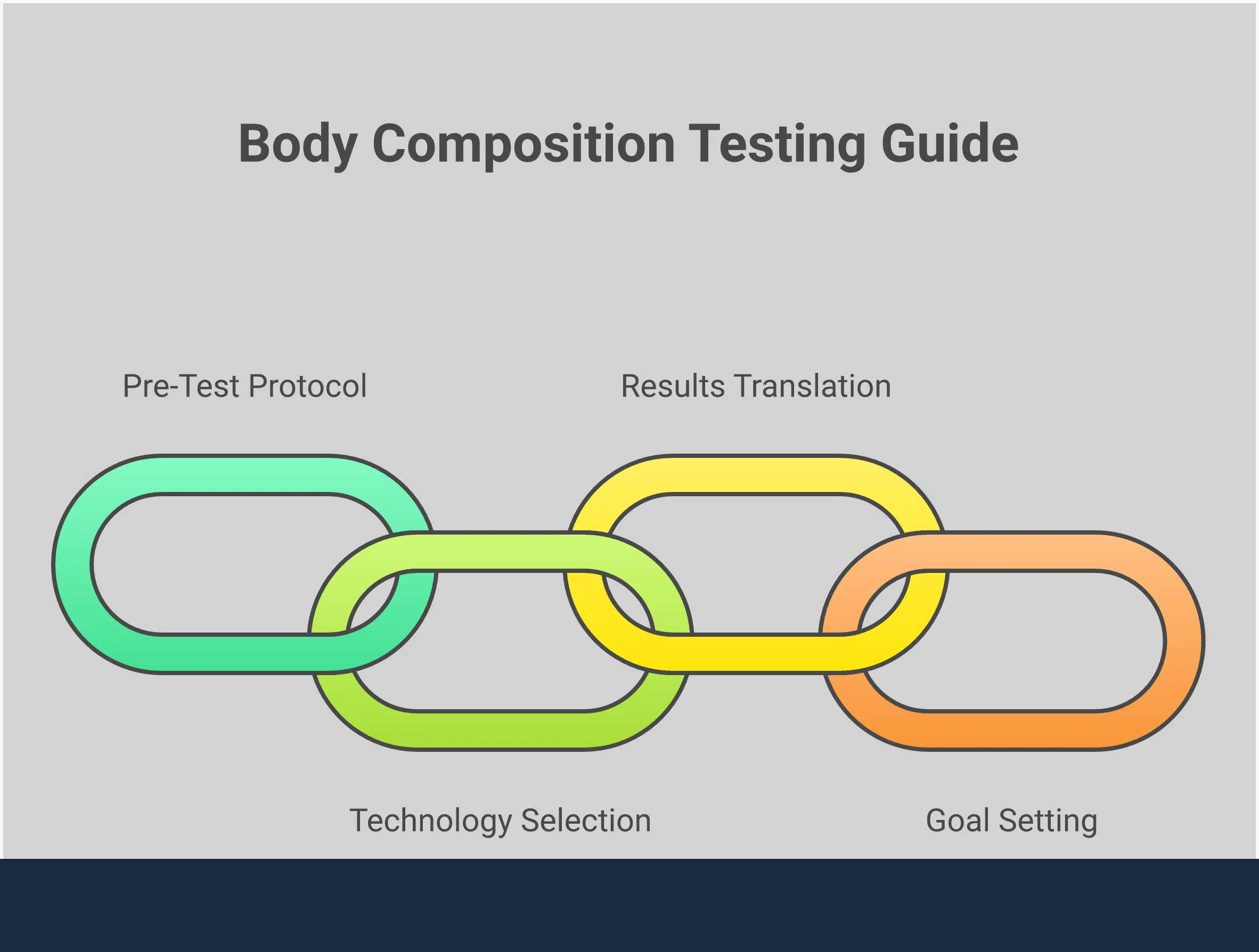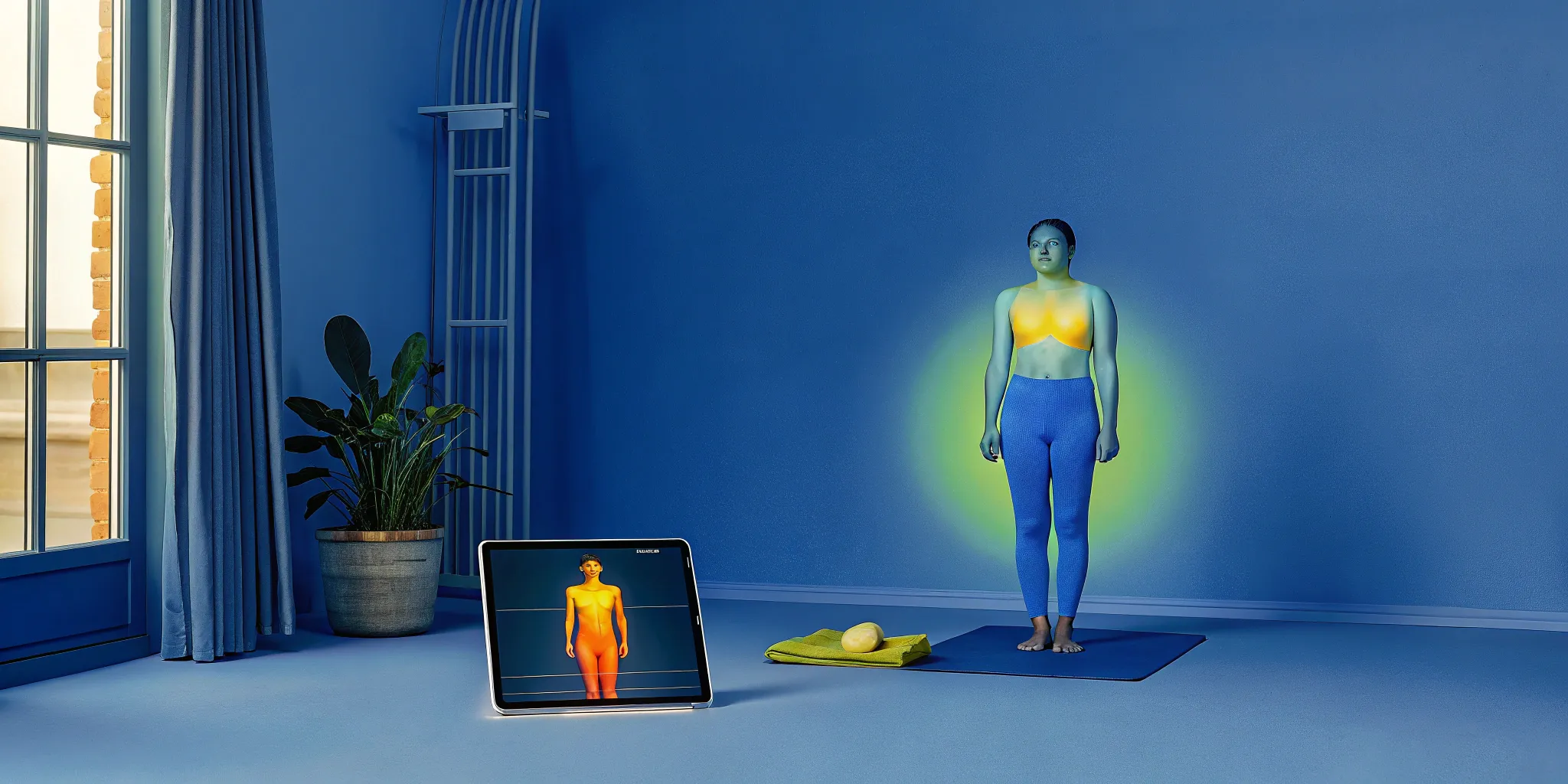Body Composition Tests: Your Guide to Getting Started


Heading 2
Heading 1
Heading 3
Heading 4
Heading 5
Heading 6
Lorem ipsum dolor sit amet, consectetur adipiscing elit, sed do eiusmod tempor incididunt ut labore et dolore magna aliqua. Ut enim ad minim veniam, quis nostrud exercitation ullamco laboris nisi ut aliquip ex ea commodo consequat. Duis aute irure dolor in reprehenderit in voluptate velit esse cillum dolore eu fugiat nulla pariatur.
Block quote
Ordered list
- Item 1
- Item 2
- Item 3
Unordered list
- zz
- Item B
- Item C
Bold text
Emphasis
Superscript
Subscript
Nothing stalls a client's progress faster than a number that won't budge. When someone puts in the work but the scale doesn't reflect it, their commitment can quickly fade. This is the critical moment where many wellness journeys end. But what if you could show them progress that the scale can't see? A body composition test does exactly that. It reveals the "non-scale victories," like successfully trading five pounds of fat for five pounds of muscle. This detailed data transforms the conversation from simple weight loss to true body recomposition, keeping your clients engaged, motivated, and confident in your program's effectiveness.
Key Takeaways
- Go Beyond the Scale: A body composition test reveals the crucial difference between fat and muscle, providing a more accurate measure of health than weight or BMI and helping you set smarter client goals.
- Establish a Consistent Pre-Test Routine: For the most reliable results, advise clients to test at the same time of day, preferably in a fasted and rested state. This removes variables and ensures you're tracking real change, not daily fluctuations.
- Turn Results into an Action Plan: Use the initial scan as a baseline to create targeted fitness and nutrition programs. Schedule follow-up tests every 3-6 months to demonstrate progress, adjust strategies, and keep clients motivated.
What is a Body Composition Test?
Stepping on a scale only tells you one thing: your total weight. But what is that weight actually made of? A body composition test answers that question by breaking your body down into its core components. Think of it as an inventory of your body, measuring the specific proportions of fat, muscle, bone, and water. This provides a much clearer and more meaningful snapshot of a person's health than a single number on a scale ever could.
For wellness professionals, this detailed data is the foundation for creating truly personalized and effective programs. Instead of just aiming for weight loss, you can help clients focus on healthier goals, like reducing body fat while preserving or building lean muscle. This shift in perspective is powerful. It helps clients understand their bodies better and see progress that might otherwise be invisible. When the scale won’t budge, a body composition test can show that a client has successfully replaced five pounds of fat with five pounds of muscle—a huge win that keeps them motivated and engaged with your health club or program.
What a Body Comp Test Measures
A body composition test provides several key metrics that paint a full picture of a person's physical makeup. The primary components measured are fat mass and fat-free mass. Fat mass is exactly what it sounds like—the total amount of fat in your body. Fat-free mass, often called lean body mass, includes your muscles, organs, bones, and water. Tracking these two allows you to ensure clients are losing the right kind of weight. Some advanced body composition techniques also measure bone mineral content and total body water, offering even deeper insights into a client's overall health and hydration status.
Why BMI Isn't the Full Picture
For years, Body Mass Index (BMI) was the standard for assessing healthy weight. It’s a simple formula based on height and weight, but it has a major flaw: it can't tell the difference between a pound of muscle and a pound of fat. This means a lean, muscular athlete could easily have a BMI in the "overweight" category, which is both inaccurate and discouraging. Body composition analysis provides the context that BMI lacks. It recognizes that two people with the same height and weight can have vastly different health profiles based on their muscle-to-fat ratio, giving you a much more reliable tool for guiding your clients.
The Benefits for Health and Fitness
Body composition tests transform the way you and your clients track progress. They provide tangible data that goes far beyond weight, helping you monitor fat loss and muscle gain with precision. This information is critical for assessing a client's overall health and nutritional status, allowing you to fine-tune their fitness and diet plans for better results. For personal trainers and weight management coaches, these tests are invaluable for setting realistic goals and demonstrating program effectiveness. When clients can see concrete changes in their body composition, their motivation soars, leading to better adherence and long-term success.
Types of Body Composition Tests
Choosing the right body composition test depends on your business goals, budget, and the experience you want to provide for your clients. Some methods are quick and accessible, while others offer clinical-grade accuracy. Understanding the differences will help you guide your clients toward the best option for tracking their progress and staying motivated. Each test provides a unique snapshot of a person's health, moving far beyond the limitations of a simple scale. Let's look at five common methods you'll encounter in the health and fitness industry.

DEXA Scans
A DEXA (Dual-Energy X-ray Absorptiometry) scan is often considered a gold standard for body composition analysis. It uses low-dose X-rays to provide a detailed breakdown of fat mass, lean mass, and bone mineral density. For clients, the process is simple and comfortable; they just lie on an open table for a few minutes while the machine scans them. The ability to measure bone density is a unique advantage, offering critical health insights, especially for older clients. While DEXA scans provide excellent accuracy, they are typically found in medical or specialized facilities and can be more expensive than other options. The detailed report gives you and your client a precise baseline to work from.
Bioelectrical Impedance Analysis (BIA)
Bioelectrical Impedance Analysis is one of the most accessible methods for measuring body composition. You'll find this technology in everything from smart scales to handheld devices. BIA works by sending a safe, low-level electrical current through the body. Since fat, muscle, and water conduct electricity differently, the device estimates fat-free mass based on the speed of the current. While convenient and fast, BIA results can be influenced by hydration levels, recent meals, and exercise. For the most consistent readings, it's best to test clients under the same conditions each time, like first thing in the morning before eating or drinking.
Hydrostatic Weighing
Also known as underwater weighing, this method was long considered a top standard for accuracy. The process involves being submerged in a tank of water after exhaling as much air as possible from the lungs. The test works on the principle that fat is less dense than bone and muscle, so a person with a lower body fat percentage will weigh more underwater. While highly accurate, hydrostatic weighing is not the most practical or comfortable experience for many clients. The need for specialized equipment and the discomfort of the procedure mean it's become less common as other technologies have advanced.
Air Displacement Plethysmography (Bod Pod)
Think of this as a dry alternative to underwater weighing. Air Displacement Plethysmography, most commonly known as the Bod Pod, measures body composition by having a client sit in a sealed, egg-shaped chamber for a few minutes. The machine calculates body volume by measuring how much air the body displaces inside the pod. From there, it can determine body density and calculate body fat percentage. The Bod Pod is non-invasive, fast, and much more comfortable for clients than hydrostatic weighing, while delivering a comparable level of accuracy. It's a great option for providing a high-tech, comfortable client experience.
Skinfold Measurements
This classic method uses calipers to measure the thickness of subcutaneous fat at several specific sites on the body. A trained professional gently pinches the skin and underlying fat layer to get a reading. These numbers are then plugged into a formula to estimate overall body fat percentage. The biggest advantage of skinfold testing is that it's inexpensive and portable, making it a popular choice for personal trainers. However, its accuracy is highly dependent on the skill of the person taking the measurements. For reliable results, it's critical that the same trained person performs the test under the same conditions each time.
How to Prepare for Your Test
To get the most accurate and useful body composition results, consistency is everything. Think of it like a science experiment—you want to control as many variables as possible so you can be confident that the changes you see are from your client's hard work, not just daily fluctuations. By creating a simple, repeatable pre-test protocol, you ensure that each scan is comparable to the last. This helps you reliably track progress, keep clients motivated, and clearly demonstrate the effectiveness of your programs, whether you're running a weight management center or a high-performance gym. Following a few simple guidelines can make all the difference in the quality of your data.
Manage Your Hydration
Your body’s water content can significantly influence test results, so it’s important to be normally hydrated. Dehydration can make body fat percentage appear higher, while being over-hydrated can skew the numbers in the other direction. The goal isn’t to chug a gallon of water right before the scan, but to maintain a consistent and healthy hydration level. Advise your clients to drink plenty of water the day before and the morning of their test, just as they normally would. Avoid alcohol and caffeine, which can have a diuretic effect and lead to dehydration. Consistency is the key to comparing scans accurately over time.
What to Eat Beforehand
For the most reliable reading, it’s best to test on an empty stomach. Undigested food and beverages add weight and can interfere with the measurements, especially for methods that use electrical currents or density calculations. The standard recommendation is to not eat for at least three hours before your scan. To make this easy and consistent, suggest that clients schedule their appointments first thing in the morning. This allows them to test in a fasted state after sleeping, which provides a clean and stable baseline for every future scan. This simple step removes a major variable and leads to much more trustworthy data.
When to Exercise and Test
A tough workout can feel great, but it can also temporarily throw off your body composition numbers. Strenuous exercise causes fluid shifts, inflammation, and dehydration from sweating, all of which can alter your results. To get a true baseline measurement, it’s best to not exercise within 12 hours of testing. Testing in a rested state ensures that the scan reflects your body’s typical composition, not its temporary post-workout condition. This is a crucial piece of guidance for personal trainers to give clients, as it prevents a great workout from accidentally skewing their progress report.
What Can Skew Your Results?
Several factors can influence a body composition test, which is why a consistent pre-test routine is so important. Test results can vary depending on your hydration status, when you last ate, if you recently exercised, and even the time of day. Your body naturally fluctuates throughout the day. To minimize these variables, establish a clear protocol. The gold standard is to test at the same time of day for every scan—ideally in the morning, after using the restroom, and before eating, drinking, or working out. This creates a repeatable state that makes your before-and-after data as accurate as possible.
How Often Should You Test?
While it’s tempting to test frequently, meaningful changes in body composition take time. Testing every week will likely just reflect normal daily fluctuations in water weight and can be discouraging for clients. A more effective and motivating approach is to schedule follow-up scans every three to six months. This timeframe is long enough to allow for genuine, measurable changes in body fat and muscle mass resulting from a consistent fitness and nutrition plan. This cadence helps clients focus on the long-term journey and celebrate substantial progress, rather than getting caught up in minor, insignificant shifts.
How to Read Your Results
Getting a body composition report can feel like looking at a page full of complex data. But once you know what each number means, you have a powerful tool to guide your clients toward their goals. These metrics offer a detailed snapshot of their health that goes far beyond the number on a scale. By understanding these key data points, you can help clients see their progress, stay motivated, and make informed decisions about their fitness and nutrition plans. For businesses like health clubs and wellness centers, presenting this data clearly is a huge part of the client experience. It transforms an abstract goal like "getting healthier" into something tangible and trackable. Instead of just focusing on weight loss, you can celebrate non-scale victories like gaining muscle or reducing harmful visceral fat. This detailed feedback loop keeps clients engaged and demonstrates the value of your services, leading to better retention and results. Let's break down the most common measurements you'll find on a body composition report so you can interpret them with confidence.
Understanding Body Fat Percentage
This is often the number people focus on first. Your body fat percentage shows how much of your total weight is made up of fat. While it’s a useful metric, it’s important to frame it correctly for clients. It’s not the only indicator of health, but it provides a much clearer picture than BMI. For weight management clients, tracking this percentage over time is a fantastic way to show that they’re losing fat, not just weight, which can be incredibly motivating. Healthy ranges vary by age and gender, but this number helps set a baseline for progress and keeps the focus on meaningful change.
Measuring Lean Mass
Lean mass is everything in your body that isn't fat—this includes your muscles, bones, organs, and water. It’s a critical metric for anyone looking to get stronger or improve their physique. When a client sees their lean mass increase, it’s proof that their hard work in the gym is paying off, even if the scale doesn't move much. Advanced tests can provide a Fat Free Mass Index (FFMI), which helps you understand how much muscle someone has relative to their height. This is especially valuable for personal trainers creating targeted strength programs and showing clients tangible results from their efforts.
What to Know About Visceral Fat
Visceral Adipose Tissue (VAT) is the internal fat that surrounds your organs. You can’t see it, but it’s a key indicator of metabolic health. High levels of visceral fat are linked to an increased risk for conditions like heart disease and type 2 diabetes. Explaining this to clients can be a real eye-opener, as it shifts the focus from aesthetics to long-term health. A body composition analysis that measures VAT gives you a concrete number to track, helping clients understand the importance of nutrition and consistent exercise for their internal well-being. It’s a powerful motivator for lifestyle changes that go beyond appearance.
Where Your Body Stores Fat
The Android to Gynoid (A/G) ratio tells you where your body prefers to store fat. An "android" or apple shape means more fat is stored around the abdomen, while a "gynoid" or pear shape means more fat is stored around the hips and thighs. Storing more fat around the midsection is associated with higher health risks. For women, a healthy A/G ratio is typically below 0.8, and for men, it's below 1.0. This metric helps you have a more nuanced conversation with clients about how their body is changing and the health benefits of reducing abdominal fat, making their progress feel more personal and significant.
Other Key Health Markers
Beyond the main metrics, your report might include others that add color to the full picture. The Fat Mass Index (FMI) is like BMI but for fat, showing how much fat you have relative to your height. You might also see your Resting Metabolic Rate (RMR), which estimates how many calories your body burns at rest. This is incredibly useful for creating precise nutrition plans. These additional data points help you and your client build a comprehensive wellness strategy that’s tailored to their unique body and goals, a service that sets premium medical spas apart.
What to Do With Your Results
Getting your body composition results is the starting line, not the finish. This data is your new baseline—a detailed, personal map that shows you exactly where a client is right now. The real power comes from using this information to build a smarter, more effective plan. Instead of relying on guesswork, you can now make data-driven decisions to help clients reach their goals faster and more sustainably. Think of it as trading a compass for a GPS. Both point you in a direction, but one gives you a much clearer path to the destination.
This detailed insight allows you to move beyond generic advice and create programs that are truly tailored to an individual's body. When clients see their progress visualized through objective data—not just the number on a scale—their motivation increases. They can see the tangible results of their hard work, like a decrease in body fat percentage or a gain in lean muscle mass. This process helps you improve client engagement and build long-term relationships founded on trust and measurable success. The following steps will show you how to turn these numbers into a powerful action plan.
Set Realistic Goals
The most valuable part of a body composition test is the insight it gives you into a client's specific physiology. A generic goal like "lose 10 pounds" doesn't distinguish between fat, muscle, and water. With detailed results, you can set much more meaningful targets. For example, a goal might become "lose 5 pounds of body fat while gaining 2 pounds of muscle." This is a more accurate reflection of progress. Using these metrics helps you manage client expectations and create achievable milestones that keep them motivated for the long haul.
Pro Testing vs. At-Home Options
There are many ways to measure body composition, and each has its place. At-home smart scales that use BIA are great for tracking daily trends, but their accuracy can be affected by hydration and other factors. For precise, actionable data, professional-grade testing is the way to go. Technologies like DEXA scans or 3D body scanners provide a much more reliable snapshot of a client's body composition. As a professional, offering this level of accuracy helps you build trust and design programs based on solid data, giving your clients the confidence that their plan is truly customized for them.
How to Track Your Progress
Consistency is key, but that doesn't mean you need to test every week. For body composition, getting a follow-up scan every 3 to 6 months is a great cadence. This gives the body enough time to show meaningful changes from a new fitness or nutrition plan. Scheduling these follow-ups helps clients stay accountable and gives them a concrete date to work toward. It also provides a perfect opportunity to review their progress together, celebrate their wins, and make any necessary adjustments. This regular, data-backed check-in process turns a single appointment into an ongoing wellness journey.
Adjust Your Fitness Plan
The data from a body composition test shows you what’s working and what isn’t. If a client’s goal is to build muscle but their lean mass has stayed the same after three months, you know it’s time to change their strength training routine or look at their protein intake. Knowing your client's exact makeup of fat and muscle is crucial for understanding how well their fitness efforts are paying off. This feedback loop allows you to be agile and responsive, fine-tuning their plan to overcome plateaus. It's a powerful tool for any health club looking to ensure clients are always moving in the right direction.
Create a Long-Term Plan
Initial results are exciting, but the ultimate goal is sustainable health. Once a client reaches their initial goals, body composition data can help you create a long-term maintenance plan. You can shift the focus from fat loss or muscle gain to maintaining a healthy body fat percentage and preserving lean mass over time. For individuals who are already maintaining their health through exercise and balanced nutrition, less frequent testing can confirm their strategies are effective. This helps clients transition from a short-term goal to a lasting, healthy lifestyle. It's a key strategy for successful weight management and long-term client retention.
Frequently Asked Questions
Which body composition test is the most accurate? While methods like DEXA scans and hydrostatic weighing are often called the "gold standards" for accuracy, the best test is the one you can perform consistently. For most wellness businesses, the key is choosing a reliable, professional-grade method that is comfortable and accessible for your clients. The goal is to get a trustworthy baseline and track changes over time, so consistency in the testing method is more important than chasing a fraction of a percentage point in accuracy between different top-tier machines.
How often should my clients get a body composition test? Meaningful changes in body fat and muscle mass take time to achieve. Testing too frequently, like every week, can be discouraging as it often just reflects normal daily fluctuations in water weight. A good rhythm for follow-up scans is every three to six months. This provides enough time for a client's hard work to show up as real, measurable progress, which is a fantastic way to keep them motivated and focused on their long-term plan.
My client's smart scale gives different results than their professional scan. Why is that? This is a very common situation. Most at-home smart scales use Bioelectrical Impedance Analysis (BIA), which can be easily influenced by daily factors like your hydration level, when you last ate, or if you just worked out. Professional tests, like DEXA or 3D scanners, use more advanced technology that isn't as affected by these variables. It's best to use at-home scales for observing general trends and rely on professional scans for the precise data you need to make adjustments to a client's program.
Is there any reason to still pay attention to BMI? Body Mass Index (BMI) can be a quick, simple screening tool for large population studies, but it's not very useful for assessing an individual's health. Its major flaw is that it can't distinguish between muscle and fat. This means it might label a very fit, muscular client as "overweight." A body composition test provides the specific details that BMI misses, giving you a far more accurate and helpful picture of a person's actual health and fitness level.
What's the most important number for my clients to focus on? It's natural for clients to fixate on their body fat percentage, but it's helpful to guide them toward a more complete picture. Encourage them to look at the relationship between a few key metrics. For example, seeing their lean mass increase while their visceral fat decreases is a huge win for their long-term health, even if their total weight on the scale hasn't changed much. Focusing on these combined changes tells a much more powerful story of their progress.




